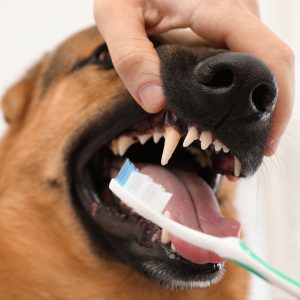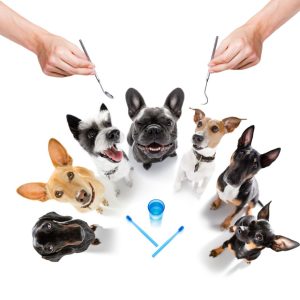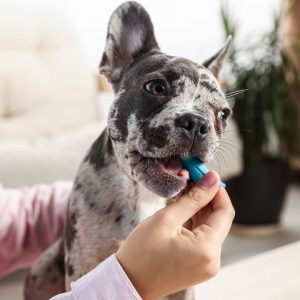Beyond the Brush: Dental Care for Your Dog

It is recommended that humans brush their teeth twice every day and go to the dentist once every six months for a check-up and professional cleaning. Now think, when was the last time (if ever) you brushed your dog’s teeth? Just like people, dogs need their teeth taken care of, too. Some dogs, specifically small dogs, are more likely to develop dental disease; their teeth are more cramped in their mouth, which allows tartar to build up more easily compared to a large dog. While dogs occasionally need to have a professional dental cleaning performed by a veterinarian, there are things you can do at home to help care for their teeth and prevent damage.
Dental Disease in Dogs

Throughout their lives, dogs develop tartar buildup on their teeth. It looks like brown or gray material stuck on their teeth that cannot come off with just a brushing. Remember that teeth can get slightly yellow with age, which is not related to tartar buildup. Many dogs also break their teeth. Sometimes, it is just a little chip that does not cause any pain or disease to the dog. Some chips and cracks are large enough that the pulp of the tooth is exposed. This causes pain for your dog and allows an opening for bacteria, leading to infection. Dogs can also get gingivitis, a type of gum disease. The best way to determine the severity of your dog’s dental disease is to ask your vet; however, there are some symptoms to watch out for at home. Tooth pain may cause your dog to struggle to eat their hard kibble, or cause them to drop pieces of food. Bad breath that does not go away can also indicate dental disease. Finally, your dog may paw at their mouth if their teeth are causing pain.
Professional Dental Cleanings

A professional dental cleaning is performed by a vet and vet techs. It involves using an ultrasonic scraper to remove tartar buildup and polishing to smooth any scratches on the teeth. This helps treat gingivitis and prevent the need for extractions in the future. Often, x-rays of all of your dog’s teeth will be performed to determine if there is a need for any extractions during the cleaning and also see if there is any dental disease occurring under the gums. Unfortunately, professional dental cleanings require that your dog is fully anesthetized as it would not be possible to complete all of this with your dog awake and moving around. This also means dental cleanings aren’t possible for some dogs that are not good anesthesia candidates due to underlying diseases. Furthermore, they can be very expensive, so caring for your dog’s teeth at home can help prevent the need for several dental cleanings throughout your dog’s life.
Dental Care at Home

The most important thing you can do to care for your dog’s teeth is to brush them as often as you can. It is best to start brushing your dog’s teeth when they are a puppy to get them used to it as ideally it will be a part of their routine throughout their whole life. However, it is still important to try brushing regardless of your dog’s age. Even brushing just once a week can help prevent the buildup of tartar. Use a dog specific toothbrush as regular human toothbrushes are not designed for a dog’s teeth and are not as effective. If using a toothbrush is too difficult with your dog, try a finger brush; it is essentially a silicone thimble with bristles and can be much easier to maneuver around your dog’s mouth than a regular toothbrush. While brushing, attempt to brush all surfaces of your dog’s teeth, but especially focus on the teeth at the back of their mouth. They often have the most tartar buildup and are most difficult and expensive to extract when necessary. Also make sure to use a toothpaste formulated for dogs as human toothpaste can contain chemicals that are harmful for dogs, such as fluoride.
 Other than brushing, you can feed your dog dental kibble or dental treats. Dental kibble is often larger pieces of kibble that encourage your dog to chew more, which in turn helps clean off their teeth and prevent tartar buildup. Dental chews work in a similar way: causing your dog to chew more and remove food stuck in their teeth. Certain toys are also formulated to help increase the amount of food removed from your dog’s teeth as they chew on it.
Other than brushing, you can feed your dog dental kibble or dental treats. Dental kibble is often larger pieces of kibble that encourage your dog to chew more, which in turn helps clean off their teeth and prevent tartar buildup. Dental chews work in a similar way: causing your dog to chew more and remove food stuck in their teeth. Certain toys are also formulated to help increase the amount of food removed from your dog’s teeth as they chew on it.
There are many products available that are advertised to help clean your dog’s teeth. Unfortunately, some are not very effective, especially when compared to brushing. Dental wipes can help a bit, but they are not as effective as tooth brushing because they can’t get into the crevices between the teeth as well. Many dental water additives and powders to put on dog food are available, but they mostly focus on improving your dog’s breath rather than improving their dental health. Some can also contain ingredients that are harmful for dogs, so always make sure your vet approves of them before trying any new products.
How to Avoid Damaging Teeth
 Dogs commonly break their teeth during play. Playing tug of war can lead to pulling a tooth out, especially teeth that are already loose due to underlying dental disease. Allowing your dog to catch harder toys can chip a tooth or knock it out entirely. Try to use soft toys when possible, or throw their toys far enough away to prevent the opportunity for your dog to catch it. Also, try to stop your dog from chewing on super hard toys; dogs often chip teeth because they are too focused on their toy to realize they are chewing too hard. Similarly, it is best to avoid all bones, raw hides, and antler treats. They can easily chip teeth, as well.
Dogs commonly break their teeth during play. Playing tug of war can lead to pulling a tooth out, especially teeth that are already loose due to underlying dental disease. Allowing your dog to catch harder toys can chip a tooth or knock it out entirely. Try to use soft toys when possible, or throw their toys far enough away to prevent the opportunity for your dog to catch it. Also, try to stop your dog from chewing on super hard toys; dogs often chip teeth because they are too focused on their toy to realize they are chewing too hard. Similarly, it is best to avoid all bones, raw hides, and antler treats. They can easily chip teeth, as well.
While it may sometimes be a pain, try your best to care for your dog’s teeth at home. Brushing and encouraging safe chewing (like with dental chews and dental kibble) will help prevent a buildup of tartar, leading to a decreased likelihood of needing a dental cleaning. Best of luck to you and your dogs with brushing!
Veterinary Oral Health Council has put together a comprehensive list (with a downloadable PDF available) of dental health products approved by veterinarians. It is best to check with your vet to see if a product is right for your dog, but this list is a good start. Check it out here: VOHC Accepted Products
The vet school at Tufts University clarifies and explains some misconceptions about dental care in dogs. See it here: Tufts Pet Dental Health: Fact or Fiction?
Veterinary Centers of America has good explanations of dental disease more in depth, including detailing the process of a dental cleaning. Find their website here: VCA Dental Disease in Dogs






































































